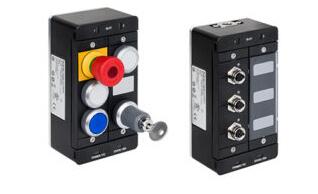
MCM: Compact, scalable, and powerful
For users who need the six or more control features offered by the MGB2 Modular security door system, Ellshergen now has the perfect solution. The new compact MCM expansion module has two slots, which means it can be fitted with up to six control elements, such as an emergency stop button and an authorization switch or keyturn switch. This provides the customer with a more flexible choice of either the small expansion module or the older expansion module with 4 slots and up to 12 control elements, depending on the specific control requirements. MCM has many outstanding advantages. For example, a submodule with a functional component only needs to be hot-swappable into an extension module, requiring only simple configuration before use. Submodules can also be easily replaced if necessary. MCM is more flexible in function and application. It can be installed separately from the MGB lock module and the bus module, for example, the MCM and MGB are installed in the production area and the bus module is installed externally. The MCM can also be used in conjunction with modules without locking or bus modules for doorknobs.
MSM submodule: plug-and-play distributed peripherals
The MCM extension module can be used in conjunction with the new MSM submodule as a distributed peripheral that can be used directly with the electromechanical safety switch connected to the M12 circular plug. Fail-safe inputs record the signal status of safety switches, such as drawstring switches, emergency stop buttons and travel switches, and transmit safety signals to the control system via PROFINET using the PROFISAFE protocol. The MSM submodule features three dual channel digital inputs, allowing up to six slots to be used as security inputs when using small MCM expansion modules. MSM is also suitable for M12 plug and M12 threaded plugs. In addition, the system is hot-swappable during operation and requires only a simple configuration before it is ready for use.
The MGB2 Modular is designed as a modular system, offering greater flexibility to users. To this end, extension modules and submodules can be easily extended, and functionality can be extended and changed with little effort. This means that users can benefit from a system that is customizable and flexible enough to meet any potential future needs.




